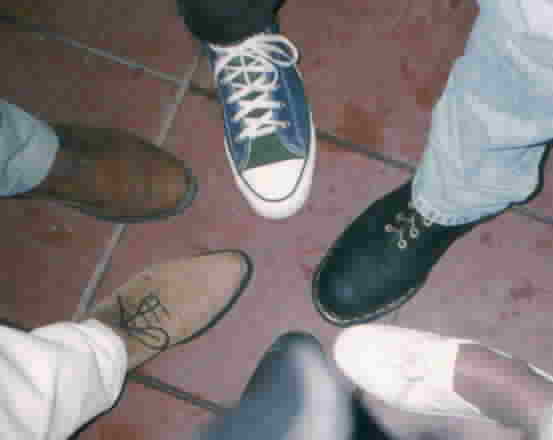BOOT

Boots--boots--boots--boots--movin' up and down again! --Kipling, Boots
I had a driving interest in footwear and the artistic possibilities of making boots. A saddle is a saddle, you just see brown leather. But boots . . . you see red, yellow, fuchsia, and chartreuse. --D.W. Frommer, bootmaker (Hadley 1993; see COLOR CUE)
. 1. A usually heavy,
protective covering for the foot,
made of leather, rubber, or vinyl. 2. A conspicuous sign
of authority and power designed to accent the foot's ability to stomp.
Usage: Nonverbally, boots suggest strength by adding a.
stature (i.e., increasing a wearer's vertical height; see
LOOM) and b. stability (i.e.,
giving steadiness to stance; see ANTIGRAVITY
SIGN).
Anatomy. Boots give us a more powerful gait
and commanding stance. The boot-shaft's snug contact with pressure-sensitive
Pacinian corpuscles of the lower leg provides tactile reassurance,
while supporting the long tendons that drop into our feet from muscles above.
Boots also stabilize the ankle joint. By adapting to the physical needs of our
feet (and to the psychic needs of our reptilian
brain) Doc Martens? helped young men and women of the 1990s feel secure
on the streets.
Cowboy boots. Fashion trainer John Molloy found that women consider men in cowboy boots more attractive than men in ordinary shoes. (N.B.: Standing on tiptoes shifts the body's center of gravity forward, causing cowboy-boot wearers to compensate by leaning forward as well. This makes the human derriere--already prominent by primate standards--protrude an additional 25% [see HIGH HEEL]). Originally adapted from the moderately high Cuban heel, American cowboy boots add about two inches to standing height. (N.B.: A man's business shoe has only a 1/2-to-3/4 inch upper base of polyethylene, and a 1/2 inch layer of rubber attached below, called a heel lift, which works as a shock absorber.)
Evolution. Boots evolved from leather sandals, as straps grew longer and thicker to support a human's congenitally weak ankles. Sandals reaching above the ankle (the oldest status symbol for feet yet discovered) were worn exclusively by Roman army officers. Gradually, the leather pieces widened until they enclosed the entire foot.
Media. By popularizing thick, buckled motorcycle boots, Marlon Brando (The Wild One 1954) and Peter Fonda (Easy Rider 1969) furthered the role of footwear as a fashion statement designed to figuratively "stomp" the establishment's powers-that-be.
Psychology. Blind-and-deaf-born children stamp their feet in anger
(Eibl-Eibesfeldt 1971:12).
Stamping. "In man, stamping the feet
in anger seems also to be a ritualized attack movement" (Eibl-Eibesfeldt
1970:96).
See also BLUE JEANS, GOOSE-STEP, LEG WEAR, MEN'S SHOES.
YouTube Video: Watch a short rendition of puss & boots.Copyright 1998 - 2016 (David B. Givens/Center for Nonverbal Studies)
"Circle of Friends and Footwear" (San Diego, California, USA; photo credit: David B. Givens [copyright 2000])